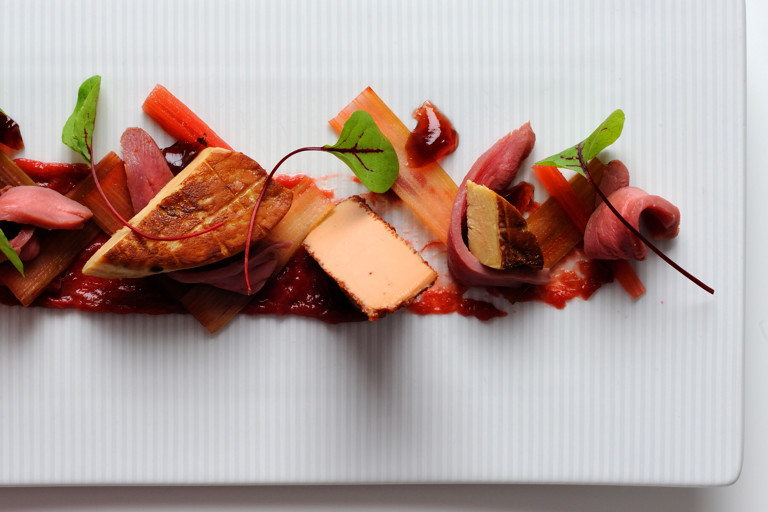Foie gras with rhubarb and duck breast
- medium
- 6
- 3 hours
Foie gras, cured duck breast and rhubarb are combined in this interesting and creative recipe from Alan Murchison. Field-grown rhubarb comes into season around April, while forced rhubarb begins its season in January.
Ingredients
Metric
Imperial
Foie gras terrine
- 200g of lobe of foie gras
- 5g of pink salt
- 7g of salt
- 10ml of brandy
- 5g of sugar
- 5ml of white wine
- 5ml of port
- 15ml of Madeira
Rhubarb chutney
- 300g of rhubarb
- 230g of sugar
- 170ml of water
- 1 vanilla pod
- 10g of orange zest
- 30g of fresh ginger, grated
Cured duck breast
- 2 duck breasts
- 100g of sea salt
Seared Foie Gras
- 1 lobe of foie gras
- 1 dash of sherry vinegar
- salt to season
Garnish
- 1 handful of micro cress, to garnish
Equipment
- Water bath
Method
For the terrine, remove the two large veins from the foie gras and pass through a fine drum sieve
- 200g of lobe of foie gras
- 300g of rhubarb
- 230g of sugar
- 170ml of water
- 1 vanilla pod, split and deseeded
- 10g of orange zest
- 30g of fresh ginger
Once the terrine curing process is complete, cook at 40°C for 3 minutes in a water bath. Turn over and cook for a further 3 minutes. Refresh in ice water
Once the terrine mixture has cooled, remove from the bag and press firmly into a small rectangle mould, cover and set in the fridge until completely cold
- 2 duck breasts
- 100g of sea salt
- 1 lobe of foie gras, Sliced into 6 even pieces
Add a dash of sherry vinegar and season with salt. Let the vinegar simmer making sure to rotate the foie gras in the pan so it coats in the vinegar and pan juices. Remove the pan from the stove and allow the residual heat to continue to cook the foie gras through
- 1 dash of sherry vinegar
- salt to season
- 1 handful of micro cress
Get in touch
Please sign in or register to send a comment to Great British Chefs.


